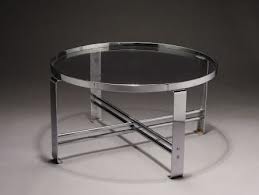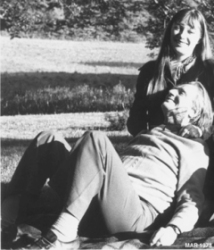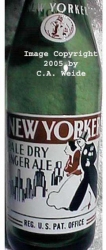
Wolfgang Hoffmann was born in Vienna, Austria in 1900. He is the son of famous architect, pedagogue and Wiener Werkstatte cofounder, Joseph Hoffmann (1870-1956). Early on, following his father’s s interests, he was trained in the decorative arts and design. Wolfgang Hoffmann once reminisced, “I spent eight years at the Realschule, then three years went to a special architectural school, where I perfected my technical knowledge of architecture and general construction. From this school, I was graduated to the Kunstgewerbeschule [Studying under Oskar Strnad and Josef Frank in Vienna]. After finishing this school, I had one and a half years of practical in a well known architect’s office. Thereafter I worked in my Father’s office for two years”.
Hoffmann met his future wife, Polish immigrant Pola (1902-1984) when they were both studying at the Kunstgewerbeschule. Joseph Urban (1872-1933) was needing an assistant for his architectural business in New York and contacted his friend and colleague, Joseph Hoffmann in Vienna. Hoffmann recommended his son Wolfgang. Urban hired him and sent a first class passage ticket to Vienna for Wolfgang to travel to New York. Wolfgang married Pola and traded his ticket for two tickets to America in steerage, arriving in New York City in December of 1925.
Leaving the Urban office after nine months, Wolfgang and Pola formed an independent design practice with offices on Madison Avenue in Manhattan with the purpose of creating contemporary interiors and industrial designs. Early work included theaters, stores, and apartments mostly in New York City.
During the late 1920’s and early 1930’s the Hoffmanns designed custom furniture for private clients. Some of these examples were shown in the February 1929 issue of House and Garden. Curiously, the examples’ design was attributed to Urban and the production to Pola Hoffmann, Inc.
Established in the fall of 1928, the American Designers’ Gallery was “devoted exclusively to showing objects and interiors for practical use… by fourteen American architects and designers”. Its members included the Hoffmans and Urban as well as ceramist Henry Varnum Poor (1888-1971), architect Raymond Hood (1881-1934), artist designer Winold Reiss (1886-1953), graphic designer Lucien Bernhard (1896-1981), decorator Donald Deskey (1894-1989), and architect Ely Jacques Kahn (1884-1972).
The Hoffmanns’ work was included in the American Designers’ Gallery’s two showcase events, its 1928 and 1929 exhibitions. Their dining alcove at the 1929 event featured a bench with a dinette table and two chairs in American walnut designed by Wolfgang and a rug by Pola.
Lucien Bernhard, fellow Austrian immigrant who settled in New York a year before the Hoffmanns, operated the gallery and decorating service Contempora with Munich resident Bruno Paul (1874-1968). The Hoffmanns, occasionally participating with Contempora, designed a number of outstanding interiors, including the constructivist living room of 1930 for Mrs. O.R. Sommerich at 40 East 66th street. In 1934, Donald Deskey commissioned Wolfgang to design birchwood furnishings for the eclectic apartment at 625 Park Avenue belonging to Helena Rubinstein.
In 1931, Wolfgang exhibited his work at the Pennsylvania Art Museum and the Museum of Modern Art in New York City. The same year, with Kem Weber (1889-1963) he organized the second and final exhibition of AUDAC- “Modern Industrial and Decorative Arts”- at the Brooklyn Museum. At this event, the Hoffmanns showed the dining room previously included in the American Designer’s Gallery’s 1929 exhibition in the Chase Bank Building lobby at 145 West 57th Street in Manhattan.
In 1932 Wolfgang was asked to assist Urban in developing the color scheme for the 1933-34 Chicago World’s Fair “A Century of Progress”. He was also commissioned to design the interior and furniture for the fair’s lumber industries house. There he executed its living and dining rooms furnished by Kroehler Manufacturing Company of Chicago; the boys’ room by Shower Brothers of Bloomington, IN; the master bedroom by Tennessee Furniture Corporation; tables and a desk inthe living room by Wabash Cabinet Company of Wabash, IN; with the bridge game furniture in the living room by Wisconsin Chair Company of Sheboygan, Wolfgang Hoffmann may have participated in other sections of the fair, since there is evidence of a Birch and Walnut cabinet manufactured by the Batesville Cabinet & American Furniture Company with Hoffmann’s name and the 1933 Fair’s trademark label in its drawer.
The Chicago exposition brought Hoffmann to the attention of the Howell Company, whose headquarters were in nearby Geneva, Illinois (later moved to St. Charles, Illinois). Hired by Howell, he was its resident designer from 1934 to 1942, offering a vast number of designs for chromed steel furniture.
Howell’s 1938 sales catalogue boasts, under a picture of its designer: “Mr. Wolfgang Hoffmann, internationally recognized as an authority in the development of authentic modern furniture, designs for Howell… and for Howell exclusively. The breadth of his experience and the flexibility of his creative genius are reflected in the complete Howell Chromsteel furniture line presented in the catalogue”. His designs for the firm combined either tubular or flat chromium plated steel with vinyl, leather, linoleum, glass, wood, and Bakelite resulting in a large number of chairs, desks, tables, and case goods; both for commercial and residential applications.
Becoming busy with Howell as his major client, Hoffmann moved to Chicago to closely supervise the production of his designs. Even though they were distinctly Modern, he shunned Streamline design, commenting, “[The style] has been employed only in aircraft design and it has nothing to do with the clean cut architecture of either a tubular chair or a table”. Of course, its exclusive use in the aircraft industry was not the case and in retrospect we see Hoffmann’s prejudice, a stance held by numerous designers at the time.
In the 1930’s the Hoffmanns divorced and dissolved their business partnership. Pola married the noted mystery writer Rex Stout and settled in a Modern house in Danbury, Connecticut. When the Howell Company converted to wartime production in the early 1940’s, Wolfgang left and became active as a professional photographer in Chicago until his death in 1969.




.png)